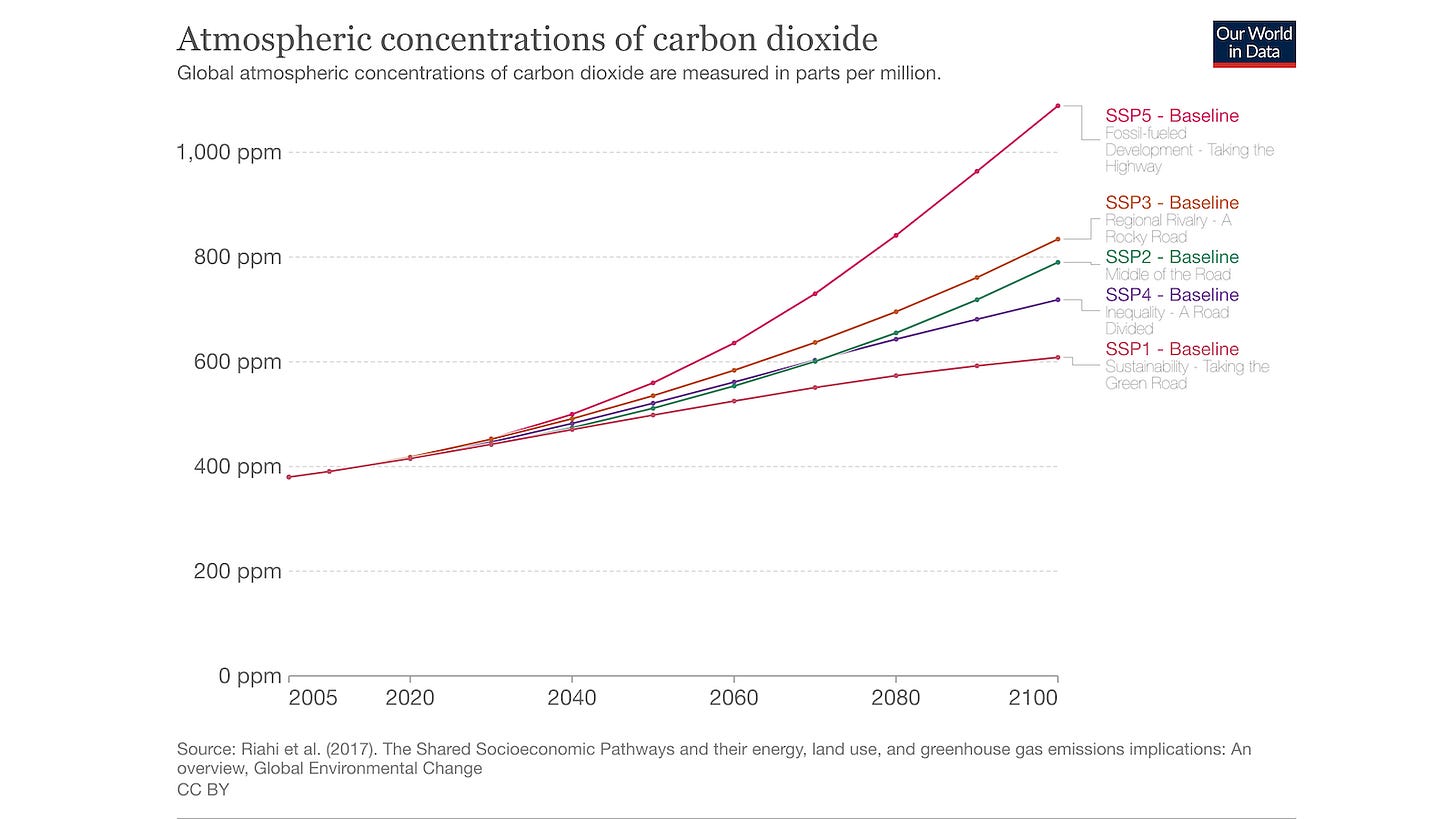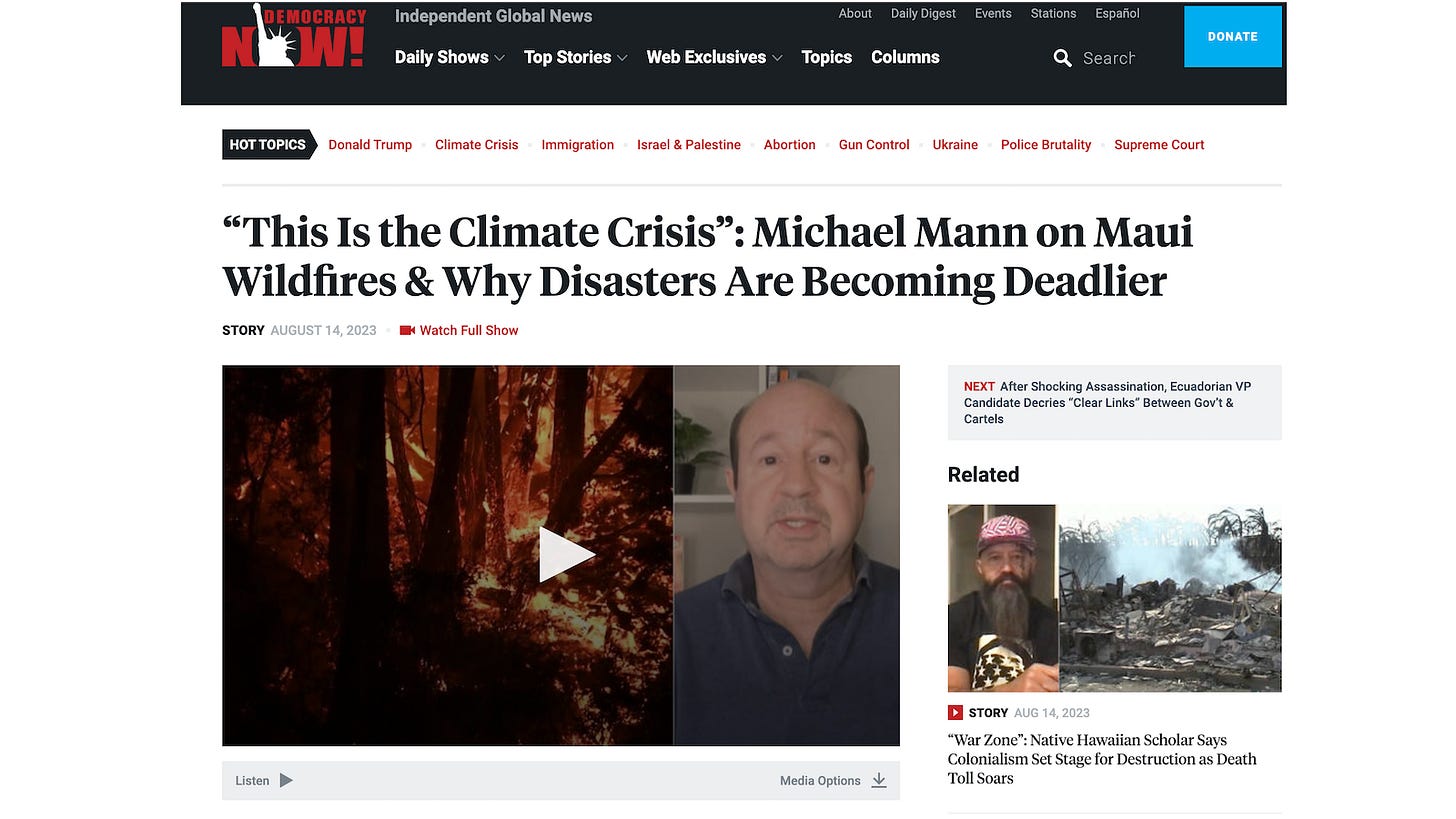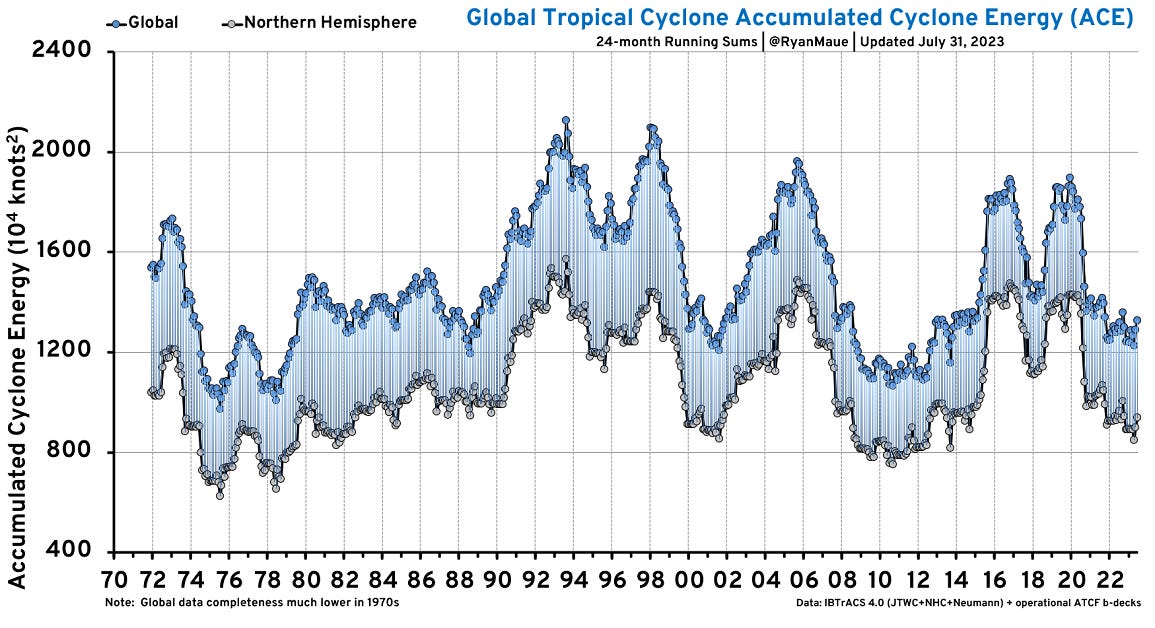Maui's wildfire tragedy caused by “green” policies, not warming
The unnecessarily large wildfires in Maui were not caused by the slow warming of climate but by “green” policies that prevented proper wildfire management.
As Congress returns to session, one topic I expect to be the subject of hearings and discussion is the wildfire tragedy in Maui. It is crucial that our lawmakers and fellow citizens know the truth about what happened, and why, so that they draw constructive lessons instead of destructive lessons. My team and I have spent a lot of time getting to the bottom of this story, and have discovered numerous errors in both mainstream and non-mainstream sources. Here are our findings, with supporting evidence.
Maui's wildfire tragedy was caused by “green” policies, not warming
The unnecessarily large wildfires in Maui were not caused by the slow warming of climate but by “green” policies that prevented proper wildfire management.
Don't let the greens scapegoat fossil fuels.
How “green” policies caused the Maui tragedy
Failure to actively manage flammable grasses and instead letting them grow “naturally”
Spending money on expensive “green” energy and not on power-line maintenance
Deprioritizing water release in favor of “green” concerns
Anti-fossil-fuel politicians are blaming Maui's tragic wildfire on climate change. But could the 2° F warming over 150 years, and any associated climate changes, make dangerous wildfires inevitable?
No. Fossil fuels are being scapegoated to evade the real villain: “green” policies.1With proper wildfire management, we could prevent anything resembling the dangerous, out-of-control wildfire Maui experienced—even if temperatures were considerably warmer.
3 keys are: fuel load management, power-line maintenance, and firefighting.
“Green” policies undercut all 3.How “green” policies undercut Hawaii's fuel load management
The key to limiting wildfire damage is reducing the burnable “fuel load”. Hawaii should have actively managed its flammable grasses to reduce fuel load. But instead, it took a “green,” hands-off approach.Maui is often viewed as a scenic natural landscape, untouched by human industry. But until recently, intensive, irrigated sugarcane plantations were present on the island. The last remnants of this industry closed in 2016 and arable land has been taken over by invasive grasses.2
Invasive grasses pose a fire hazard because they dry out quickly and unlike sugarcane, don't get irrigated. In combination with strong winds present in the area, this allowed for a rapid spread of fires.
Thus, experts warned for years that Maui’s grasses were a threat.3With rising population in Maui County and the knowledge about land use changes that pose a higher fire risk, you would expect active management of the landscape—e.g., with prescribed fires and fire breaches to protect the infrastructure and population. But this didn't happen.
Instead of focusing on the need for wildfire management, Maui has been preoccupied with “green” goals like its “Wetlands Restoration and Protection.” Observe that wildfire prevention isn’t a priority on Maui’s government website.4
In recent years government reports found increasing wildfire hazards, identifying insufficient fuel load management and human ignition as causes. Yet Hawaii decided to spend a fraction of what other states spend on wildfire protection. While spending a fortune on “green energy.”5
How “green” policies undercut Hawaii's power-line maintenance
Given Maui's susceptibility to wildfires—in large part because of bad vegetation management—power-line maintenance should have been a priority to prevent fires from starting. Instead, money went into “green” energy projects.About 70% of the electricity supply for the ~1.5 million population of Hawaii is generated by oil. But Hawaii is engaging in aggressive solar rooftop programs with the goal of reducing CO2 emissions by 70% by 2030, in line with political demands, which drains funds and diverts focus.6
While Hawaii and Hawaiian Electric are spending money on expensive solar and battery incentives, HI’s only coal plant was shut down in 2022, leading to a significant rate increase as it had to be replaced with oil use. Hawaiian Electric hopes expensive “green” solar will save money someday.7
Hawaii's government increasingly pushes for more “green” energy. Since 2001 the state has had a Renewable Portfolio Standard, dictating 100% “green” electricity by 2045. A number of state financial incentives have been implemented to favor expensive rooftop solar—driving up costs.8
Unsurprisingly, Hawaii's favoritism for “green” energy projects correlated with residential electricity rate increases almost 60% above that of the US average. While the price per kilowatt hour in Hawaii was about twice that of the US average in 2000, now it's almost 3 times that.9
How “green” bureaucracy prevented transmission line safety
In 2022 there was a chance to prevent the hazard of transmission lines igniting devastating wildfires when the local electric monopoly informed regulators. But thanks to “green” regulators and stakeholders, nobody acted.In 2022, recognizing the fire threat, Hawaiian Electric proposed raising rates to fund 190 million dollars across Hawaii to clear transmission lines and harden infrastructure. The regulatory process and stakeholder concerns delayed this.10
Incompetence: Despite the known fire hazards from dry vegetation combined with vulnerable power lines (the likely ignition source of the devastating fire) there was no effective plan to shut down power in case of strong winds with the potential to knock over power lines.
Given the complacency regarding fuel load from dried vegetation and the lack of maintenance of power grid infrastructure, it was only a matter of time before a serious fire threat would emerge. When it did, “green” water management considerations trumped firefighting potential.
How “green” policies undercut Hawaii's firefighting
Once wildfires started Maui needed maximum firefighting resources, including abundant water. But West Maui Land Co. was denied stream water for several hours by authorities to preserve water for a downstream traditional farmer.On August 8, Hawaii's Department of Land and Natural Resources (DLNR) refused to allow the diversion of freshwater from streams to help fight the fires before they spread. The delay took 5 hours, at which point it couldn’t help with anything according to West Maui Land Co.11
Whether the earlier diversion of stream water to increase the firefighting potential would have made a difference or not, it was terrible. In an emergency, you want to err on the side of having more tools and resources than you need, not regret having too few later.
Instead of starting a serious discussion about emergency water policies to save lives in the future, green activists and some media outlets turned this into a story about colonialist corporate greed that harms native victims and their traditional relationship with “sacred” water.12
Hawaii's Commission on Water Resource Management's M. Kaleo Manuel has drawn attention for his expressed views of water as “sacred”; something to be “revered.” One has to wonder whether that played a role in the disastrous priorities preceding the fire.13
Investigation into the responsibility of the Hawaii Commission on Water Resource Management is necessary, but water allocation concerns were unacceptable in the face of a life-threatening emergency. This problem has been foreseen but legislators would not act when warned.
In 2022, there was a proposal in the Hawaiian Senate to make water available for firefighting, noting the vulnerability of West Maui. But the proposal didn't even get a hearing. Despite the life-and-death emergency, this was not a priority over “green” habitat and climate policy.14
Don't allow greens to scapegoat fossil fuels for the Maui tragedy
Rising CO2 levels from fossil fuel use are at most a minor wildfire variable that we have little near-term control over.
“Green” policies are the major variable and can be reversed immediately.
Blaming fossil fuels is deadly.Even if 100% net-zero energy is just a few decades away (absurd) that means that rising CO2 levels will be with us for decades—and it'll take even longer for CO2 to return to today's levels. Thus, rising CO2 is a very long-term issue—not at all addressable for fire hazards now.15
Unfortunately, many commentators, instead of admitting that the root cause of Hawaii’s wildfire problems is their bad land, maintenance, and water policies—something fully within their control to fix—blame rising CO2 levels, a minor factor that is totally outside Hawaii’s control.16
Does this mean that rising CO2 levels had zero effect on the climate conditions in Maui?
No. It means they had at most a minor effect that is largely outside our control. Our focus should be on the major cause we can change: “green” policies preventing proper fire management.It's valuable to understand the effects of rising CO2 levels on local climate conditions, including wildfire conditions, but we must be 1) evenhanded (looking at - and + impacts), 2) precise, and 3) honest (not claiming to know more than we can).
Most commentators violate all 3.Commentators who blame adverse climate conditions on rising CO2 aren't evenhanded, they only look for negatives.
Any global climate change will have significant local positives, even if outweighed by negatives. But we never hear “climate change” credited with any positives.Commentators are eagerly looking for any speculative connection between changes in climate and wildfires. But the world burns less than it used to. Yet few consider that rising CO2 may lessen at least some fires due to more precipitation or changing winds.17
Despite the positive overall trend on wildfires, we only hear about worsening wildfire trends and how this is connected to human-caused climate changes, giving the public the impression that the world burns far more every year as we warm.
Those who blame adverse climate conditions on rising CO2 aren't precise—they exaggerate.
It's not clear rising CO2 has any significant effect on Maui's drought conditions or wind speeds. It certainly didn’t cause all of the challenging conditions.
Yet fossil fuels are blamed above all.Those who blame adverse climate conditions on climate change aren't honest—they pretend way more certainty than can possibly exist.
Long-term climate impacts might have played some role in the Maui wildfires, but this is not at all certain in any direction.Climate catastrophist Michael Mann immediately commented about the Maui wildfires “This is the climate crisis. It’s here and now,” despite the lack of evidence. Instead of being honest about what we don't know, he falsely professed certainty that rising CO2 caused Hawaii’s weather.18
Hawaii's governor Green agreed that climate change “amplified” the “cost of human error” in response to the fires. He can’t possibly know what role global climate change had, but he like so many others is trying to evade the obvious major culprit: Hawaii’s “green” policies.19
Weeks later, Governor Green again blamed climate change for the fire danger, claiming “we all have to acknowledge that this is a global problem, it was a very hot, dry, terrible storm.”
Exactly wrong. The world is burning less. It's a local problem of bad government priorities.20“Experts” try to connect the specific conditions of the Maui fire to rising CO2 levels, but recent analysis of climate model predictions cannot attribute drought in Hawaii to climate change.21
Maui's fires were rapidly spread and possibly ignited by strong winds, which knocked over transmission lines. There are many ways in which rising CO2 levels could have impacted Hurricane Dora but it's not clear if and how rising CO2 has impacted this particular weather event.
While there is theoretical potential for a warmer climate to slightly increase the strength of hurricanes (and reduce their frequency), the precise net effect on a specific weather today is unknowable, especially since there is huge hurricane variability over years and decades.22
Obsession with attributing conditions to climate change is not an attempt at evenhanded, precise, honest scientific understanding, but dishonest scapegoating of fossil fuels—which are a crucial value we need for everything in life, including mastering dangerous wildfires.
Fossil fuels provide the vast majority of Maui's energy and the industries that sustain the population of Hawaii, which all rely on affordable fossil fuels, from tourists flying in, to agriculture that requires equipment, fertilizers, and pesticides based on fossil fuel energy and materials.
Hawaii is ~70% powered by oil. The more Hawaii tries to forcibly reduce fossil fuels, the more it will have higher energy prices and less energy security.
Fossil fuels are crucial for Hawaii, including powering all the machines needed to manage fuel load, maintain power lines, and fight fires.If policymakers want to slow rising CO2 levels, the only path is to liberate low-CO2 energy innovation—e.g., nuclear—so it becomes globally cost-effective. Instead, “green” policymakers have criminalized nuclear and made all energy development expensive.23
Summary: The Maui tragedy was caused by “Green” policies
Failure to actively manage flammable grasses and instead letting them grow “naturally”
Spending money on expensive “green” energy and not on power-line maintenance
Deprioritizing water release in favor of “green” concerns
Popular links
EnergyTalkingPoints.com: Hundreds of concise, powerful, well-referenced talking points on energy, environmental, and climate issues.
My new book Fossil Future: Why Global Human Flourishing Requires More Oil, Coal, and Natural Gas—Not Less.
“Energy Talking Points by Alex Epstein” is my free Substack newsletter designed to give as many people as possible access to concise, powerful, well-referenced talking points on the latest energy, environmental, and climate issues from a pro-human, pro-energy perspective.
Hawaiian Electric - Hawaiian Electric sees brisk pace of solar installations
Hawaii State Energy Office - Tax Incentives
Hawaii’s electricity is ~78% petroleum-based but some of that is biofuel.
U.S. Energy Information Administration - HI State energy profile

















We are already seeing this same scenario in Utah with the Great Salt Lake. My husband recently showed me an article on a bunch of environmental groups suing the state of Utah for not conserving the Salt Lake and hence- the drying lake is blamed for more arsenic in the air... And yes, it’s a priority to maintain the lake, but year after year homeowners with small plots of land are told that the reservoirs are low and there’s not enough water for their tiny farms. And one of the top three reasons environmentalists are saying they are suing the state for the water in the lake dropping is that the state is ignoring (you guessed it) climate change. Obviously my red flags go up. I suspect, the meaningful change they are suing for would be less water for small, independent farmers and gardeners who are already paying the price of not being able to grow. Meanwhile, who knows how much water is used in the ever polluting copper industry here (a brown haze flows from the copper mine over the lake and the valley of toxic substances that the state turns a blind eye to and decreases air quality standards and hides environmental impact on autism rates locally to obfuscate- all issues which are plainly visible with a naked eye). The strip mining for silver and copper leave the hills carved into which as soon as winds pick up, blow whatever is in those hills all around the valley. So, what will be done??? I don’t know but I’m sick of “climate change” the bill for which always ends up on the foot of the tiny farmers and random homeowners, is going to save the Salt Lake much less stop any of the pollution caused by factors the state is truly ignoring. If “going green” means destroying farm land and creating more desert around a salt lake they intend to fill back up to save a bird sanctuary, the birds won’t last long in their competition for fresh air against a desert, strip mining for copper and silver and the sand filled with toxic metals flying through the air. Once upon a time the lake and humanity (small independent farmers) flourished here. The only thing that has changed that is that a few mining industries haven’t cleaned up their act. And no one seems to be pointing any fingers their way. Just climate change, climate change, climate change...
The entire climate movement is based on a gross exaggeration of the role of greenhouse gases. For a great takedown of this fundamental lie, watch this interview with 2022 Nobel Laureate (Quantum Physics) John Clauser:
https://www.theepochtimes.com/epochtv/nobel-laureate-john-clauser-there-is-no-climate-emergency-climate-models-miss-one-key-variable-5486017?utm_source=Goodevening&src_src=Goodevening&utm_campaign=gv-2023-09-05&src_cmp=gv-2023-09-05&utm_medium=email&est=5%2FlI5MN2mLb0hHDwR399RUMGSB8T6%2BTHOcenCH6GX%2Fd0xjjUeziEdsl38ZatAuOvt9x3